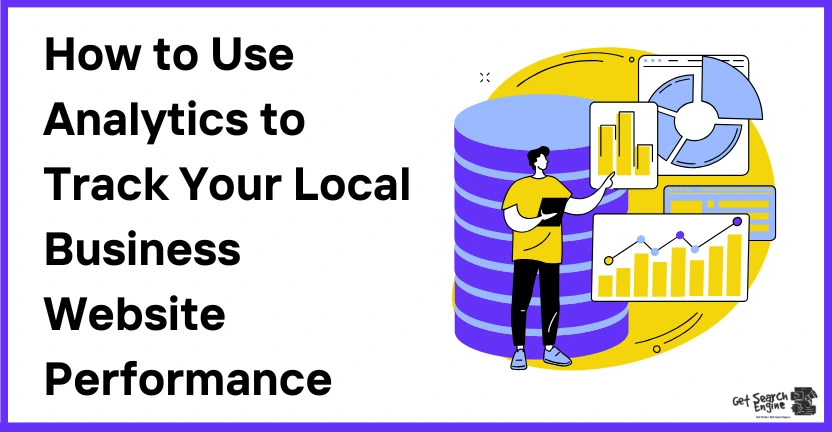In today’s digital age, having a website is essential for local businesses looking to attract more customers. However, simply owning a website isn’t enough. To truly benefit, business owners must understand how their website performs. That’s where analytics comes in. Website analytics provides valuable insights into how users interact with your site, including where they come from, how long they stay, and what actions they take.
Analytics is more than just numbers; it’s a roadmap to improving your online presence. By tracking key metrics, you can identify what’s working and what needs improvement. This boosts your website’s performance and helps you make informed decisions about marketing strategies. For local businesses, using tools like Google Analytics and Google Search Console can give a deeper understanding of how your website supports your goals.
Key Reasons Why Analytics Is Important for Local Businesses
- Improves Online Visibility: Analytics helps you track your website’s performance in local searches, ensuring it reaches the right audience.
- Optimizes User Experience: By studying user behavior, you can make data-driven changes to improve navigation and engagement.
- Drives Better Marketing Decisions: Analytics shows which campaigns are effective, helping allocate resources efficiently.
- Supports Local SEO Efforts: Tools like Google Analytics highlight local traffic trends, ensuring your website meets the needs of your target audience.
Local businesses can gain a competitive edge by utilizing website analytics, ensuring consistent growth, and improving their customers’ online experience.
Understanding Key Metrics to Track
- Tracking the proper metrics is essential for understanding your local business website’s performance. These metrics clearly show user behavior, helping you make informed decisions to improve your site’s effectiveness. Below are some key metrics every small business should monitor:
1. Website Traffic
- This metric shows the total number of visitors to your website. It helps you understand whether your marketing strategies are driving enough traffic. Monitoring traffic from specific regions is vital for businesses to assess local audience engagement.
2. Traffic Sources Knowing how visitors find your website—whether through search engines, social media, or direct visits—is crucial. This information helps you allocate resources to the most effective marketing channels.
3. Bounce Rate
- The bounce rate measures the percentage of users who leave your site after viewing a single page. A high bounce rate might indicate poor user experience or irrelevant content. Reducing this metric can significantly boost engagement and conversions.
4. Session Duration
- This refers to the average time users spend on your site. Longer session durations suggest engaging and relevant content, which is key to retaining visitors.
5. Conversion Rate
- Conversions track the percentage of users who complete a desired action, such as filling out a form or purchasing. This directly reflects the effectiveness of your website in achieving business goals.
- Monitoring these metrics regularly helps small business owners understand website performance and identify areas for improvement, leading to sustainable local business growth.
Setting Up Analytics for a Local Business Website
Setting up analytics tools is the first step to understanding your website’s performance. It ensures you can track essential data that supports your business goals. Below is a concise guide on how to get started:
Step 1: Install Google Analytics
- Sign up for a Google Analytics account.
- Add your website as a property and generate the tracking code.
- Embed the tracking code into your website’s header section or use a plugin if you are using platforms like WordPress.
Step 2: Connect Google Search Console
- Verify your website ownership in Google Search Console.
- Link it to your Google Analytics account for better insights into search performance.
Step 3: Configure Goals
- Define specific actions you want users to complete, such as form submissions or purchases.
- Set these as goals within Google Analytics to track conversion rates effectively.
Google Analytics and Google Search Console are essential SEO analytics tools that provide actionable insights. By following these steps, small business owners can quickly learn how to use analytics for small business websites. These tools help track website performance, identify user behavior, and optimize strategies for better results.
Leveraging Analytics to Optimize Website Performance
Using analytics data effectively can significantly enhance your website’s performance and ensure it meets business goals. Local businesses can create a seamless online experience that attracts and retains customers by identifying issues and opportunities. Here are practical ways to use analytics for optimization:
1. Identify Poorly Performing Pages
- Use tools like Google Analytics to locate pages with high bounce rates or low session durations.
- Example: If a product page has low engagement, consider improving the content, adding visuals, or simplifying navigation.
2. Enhance User Experience
- Analyze user behavior reports to identify areas where visitors drop off.
- Example: If mobile users struggle to navigate, implement a responsive design to ensure the website is mobile-friendly.
- Tools like heatmaps can provide additional insights into how users interact with your site.
3. Focus on High-Conversion Keywords
- Monitor organic traffic reports to identify keywords driving the most conversions.
- Example: If “best local bakery” is a top-performing keyword, optimize your content around similar terms to attract more visitors.
- This is a critical component of local SEO optimization.
4. Track Website Traffic by Source
- Identify the channels bringing in the most traffic, such as search engines, social media, or direct visits.
- Example: Invest more in those platforms if social media drives significant traffic.
Businesses can consistently analyze and act on this data to improve website performance and achieve better results. Incorporating local SEO analytics tips ensures that optimizations align with regional search trends, driving targeted traffic and boosting growth.
Tracking Local SEO Performance with Analytics
Tracking the performance of your local SEO efforts is crucial to ensure your website reaches the right audience. Analytics tools help monitor essential metrics, such as keyword rankings, traffic trends, and visibility in local search results. Here’s how to effectively use analytics for local SEO tracking:
Key Areas to Track:
- Local Keyword Rankings
- Use tools like Google Analytics and Google Search Console to identify which keywords drive traffic to your website.
- Focus on optimizing high-performing local keywords to improve visibility in search results.
- Local Traffic Trends
- Monitor website traffic by region to ensure your audience is primarily from your target location.
- Example: Increasing traffic from your service area indicates successful local SEO strategies.
- Business Visibility in Map Packs
- Use Google My Business insights to track impressions, clicks, and customer actions like phone calls or direction requests.
- This helps understand how often your business appears in local map results.
Recommended Tools
- Google Analytics and Google Search Console: Best tools to monitor website performance for local businesses.
- Google My Business Insights: Essential for tracking map pack visibility and user engagement.
By regularly analyzing these metrics, businesses can refine their local SEO strategies to ensure continued growth and better engagement with their local audience.
Common Mistakes to Avoid When Using Analytics
While website analytics can significantly enhance your understanding of site performance, some common mistakes can lead to misleading conclusions. Here are a few errors to avoid and how to address them:
1. Misinterpreting Data
- Mistake: Concluding without understanding the context of metrics like bounce rate or session duration.
- Solution: Always analyze metrics alongside related data, such as traffic sources and user behavior.
2. Ignoring Mobile Traffic
- Mistake: Focusing solely on desktop users when mobile visitors make up significant traffic.
- Solution: Use analytics tools to track mobile performance and ensure your site is mobile-friendly.
3. Overlooking Regular Monitoring
- Mistake: Checking data sporadically instead of maintaining consistent analysis.
- Solution: Schedule routine reviews to track website traffic trends and identify changes early.
4. Focusing on Vanity Metrics
- Mistake: Prioritizing metrics like total visits over actionable ones like conversions.
- Solution: Set clear goals and focus on metrics that align with your business objectives.
Avoiding these mistakes ensures your analytics efforts lead to accurate insights and better decision-making.
Conclusion
In today’s competitive market, leveraging analytics is essential for local businesses to thrive online. By understanding key metrics, such as traffic sources, bounce rate, and conversions, business owners can make informed decisions to optimize their websites. Tools like Google Analytics and Google Search Console provide actionable insights that help track local business website performance effectively.
To stay ahead, it is essential to monitor these metrics consistently, focus on improving user experience, and refine local SEO strategies.
Use analytics today to identify growth opportunities and ensure your website becomes a powerful tool for business success.






Leave a Reply